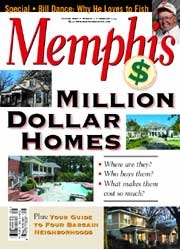Colonial Acres
Colonial Acres the next High Point Terrace- Excerpt

Colonial Acres
Now let's migrate further east again. Even before World War II, the upscale suburbs of Chickasaw Gardens, Red Acres around Galloway golf course, and Hedgemoor formed an affluent band that centered on the early 1950s development of Poplar Plaza, the first large-scale shopping center in Memphis that was truly a rival to downtown.
Less pricey developments of the same time period spread out as far as Frayser, Raleigh, and Whitehaven. Berclair is a close-in neighborhood from this period that seems to have strong potential for renovation. The Village, on the other hand, southeast of the intersection of Poplar and Goodlett, already has gone from affordable to upscale. Just as the better neighborhood along Tuckahoe Road has gone from upscale to astonishing.
The area that seems ripe to be the next High Point Terrace is Colonial Acres. High Point was a starter-home development on spacious lots that had largely become rental property. Now that neighborhood has improved to the point where there's no rental property left and certainly fewer first-time home buyers.
Colonial Acres is the area immediately south of Park Avenue between South Perkins and Estate Drive. Like High Point Terrace and Cooper-Young before that, this area has many residents who have owned these homes since the late 1950s and early 1960s. Turnover is inevitable.
The housing stock is minimally traditional with some modernist touches. The lots are ample and the location is impeccable. Even now the values aren't a steal. This is prime real estate and the average price on recent sales is between $75 and $80 a square foot. Even so, there's room for further growth.
The houses in Colonial Acres have more than location going for them. They are stylistically a perfect match for new homeowners enamored of Mid-Century Modern design. Although largely brick, the facades reflect an asymmetrical ranch-style plan with long horizontal bands of windows that wrap corners, playing off against large-scale picture windows which flood public rooms with light.
Long raised planters parallel the covered walk from driveway to front door. These vestigial front porches aren't deep enough for a rocker but the rear patio more than compensates as an outdoor living area. And it's worth noting that in the back yards — where folks really hang out — is an abundance of mature shade trees. Front yards have a surprising absence of tree cover; more trees here would certainly enhance the curb appeal of the neighborhood. Carports are more the norm than garages. Some of them even have jauntily angled shed roofs supported by iron posts.
Inside, open public areas flow casually from living to dining rooms out to rear family rooms and patios. Sometimes floors are hardwood, but often carpet is pervasive. The hardwood could always be bleached and pickled to add a modernist touch. Don't forget that underneath that carpet is an original slab of concrete that can be exposed, scored, and stained. Those kind of changes and some contemporary lighting would do wonders to update these eminently livable ranchers for the next generation.
Excerpt from
For a copy of the complete article, email web coordinator below.
Email us
cameraart@juno.com


